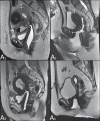Magnetic resonance imaging of the vagina: an overview for radiologists with emphasis on clinical decision making
- PMID: 26379324
- PMCID: PMC4567364
- DOI: 10.1590/0100-3984.2013.1726
Magnetic resonance imaging of the vagina: an overview for radiologists with emphasis on clinical decision making
Abstract
Magnetic resonance imaging is a method with high contrast resolution widely used in the assessment of pelvic gynecological diseases. However, the potential of such method to diagnose vaginal lesions is still underestimated, probably due to the scarce literature approaching the theme, the poor familiarity of radiologists with vaginal diseases, some of them relatively rare, and to the many peculiarities involved in the assessment of the vagina. Thus, the authors illustrate the role of magnetic resonance imaging in the evaluation of vaginal diseases and the main relevant findings to be considered in the clinical decision making process.
A ressonância magnética é um método com alta resolução de contraste e por isso muito utilizada na avaliação de doenças ginecológicas pélvicas. No entanto, seu potencial para diagnóstico de lesões vaginais ainda é subestimado, provavelmente em razão da escassa literatura referente ao tema, da pouca familiaridade dos radiologistas com doenças vaginais, algumas delas relativamente raras, e das muitas peculiaridades em um exame para avaliação desta víscera oca. Desta forma, ilustraremos neste estudo o papel da ressonância magnética na avaliação das doenças vaginais e os principais achados relevantes para a conduta clínica.
Keywords: Congenital malformations; Magnetic resonance imaging; Tumors; Vagina.
Figures


















References
-
- Walker DK, Salibian RA, Salibian AD, et al. Overlooked diseases of the vagina: a directed anatomic-pathologic approach for imaging assessment. Radiographics. 2011;31:1583–1598. - PubMed
-
- Junqueira BL, Allen LM, Spritzer RF, et al. Müllerian duct anomalies and mimics in children and adolescents: correlative intraoperative assessment with clinical imaging. Radiographics. 2009;29:1085–1103. - PubMed
-
- Siegelman ES, Outwater EK, Banner MP, et al. High-resolution MR imaging of the vagina. Radiographics. 1997;17:1183–1203. - PubMed
-
- Chavhan GB, Parra DA, Oudjhane K, et al. Imaging of ambiguous genitalia: classification and diagnostic approach. Radiographics. 2008;28:1891–1904. - PubMed
-
- Giusti S, Fruzzetti E, Perini D, et al. Diagnosis of a variant of Mayer- Rokitansky-Kuster-Hauser syndrome: useful MRI findings. Abdom Imaging. 2011;36:753–755. - PubMed
LinkOut - more resources
Full Text Sources
Other Literature Sources
